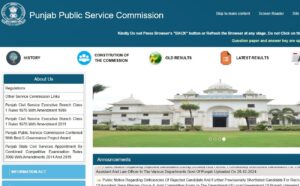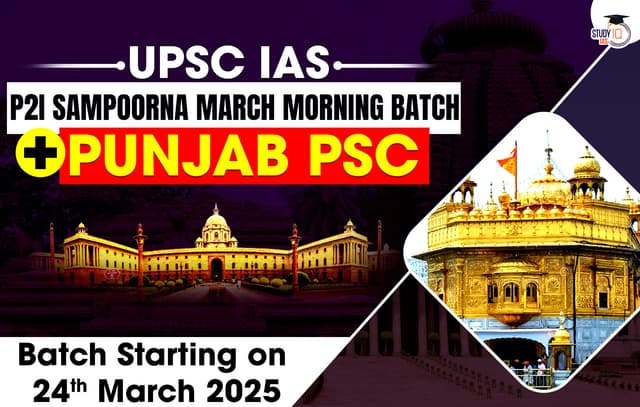Table of Contents
Why did such movements arise?
- National Awakening: Early 19th century saw the beginning of a national awakening in India, triggered by British colonial rule.
- Response to British Influence: British brought rationalism and humanism, which contrasted with India’s traditional practices like superstition, idolatry, and caste exploitation.
- Societal Stagnation: India was in a state of decline due to stagnant societal practices, while Europe experienced the Renaissance, which influenced intellectual and social reforms.
- Raja Ram Mohan Roy’s Role: The reformist ideas were spread by thinkers like Raja Ram Mohan Roy who is known as the Father of Indian Renaissance.
- Intelligentsia’s Contribution: Enlightened Indian thinkers, influenced by European philosophers like Locke and Rousseau, pushed for socio-religious reforms.
Key Socio-religious Movements in Punjab
The Nirankari Movement (1851)
- Founder: Baba Dayal Das.
- Core Belief: Worship of the formless God (Nirankar) and rejection of idolatry and Brahmanical rituals.
- Moral Guidelines: Followers were to live ethically by avoiding bad habits (meat-eating, drinking, lying, etc.) and working honestly.
- Key Contributions:
- Standardized rituals related to birth, marriage, and death based on Sikh scriptures.
- Set up Nirankari Darbars (worship centers) and had its own priests.
- Became a permanent subsect of Sikhism after the Partition, shifting its headquarters to Chandigarh.
The Singh Sabha Movement
- Origin: Started in 1873 as a response to Christian missionary activities and conversions in Punjab.
- Key Leaders: Sardar Thakur Singh Sandhewalia, Gyani Gian Singh, Baba Khem Singh Bedi.
- Goals:
- Restoration of Sikhism’s Purity: Revival of the teachings of Sikh Gurus.
- Religious Literature: Publication of Sikh literature in Punjabi.
- Education: Campaign against illiteracy and promotion of education in Punjabi.
- Expansion:
- First unit formed in Amritsar.
- Branch opened in Lahore in 1879.
- By the end of the 19th century, over 100 Singh Sabhas were formed across Punjab.
- Established Khalsa Diwan (1883) and Chief Khalsa Diwan (1902) to coordinate Sikh religious efforts.
- Impact:
- Formation of Khalsa Vidyarthi Sabha (1891) for Sikh students.
- Establishment of Khalsa College in Amritsar (1892).
- Formation of Sikh Education Conference (1908).
- The movement eventually led to the creation of Shiromani Gurdwara Parbandhak Committee (SGPC) in 1920, which became instrumental in the Gurdwara Reform Movement.
Namdhari or Kuka Movement
Overview
- Name: Namdhari or Kuka Movement, named after the practice of reciting “Gurbani” in a high-pitched voice (Kook in Punjabi).
- Founder: Officially founded by Satguru Ram Singh (1816–1885), born in Bhaini, Punjab. The movement was carried forward by his disciples like Balak Singh and Ram Singh.
- Date of Foundation: 12th April 1857 at Bhaini Sahib.
Core Beliefs
- Emphasized austerity and the importance of repeating God’s name (Nam Karna).
- Rejected religious rituals except for chanting God’s name.
- Rejected British influence, advocating for self-reliance.
Key Activities and Reforms
- Boycott of British Institutions:
- Boycotted British education, laws, products, and postal services.
- Advocated for the use of hand-woven clothes.
- Non-Cooperation & Civil Disobedience:
- Focused on Non-Cooperation and Civil Disobedience similar to Gandhi’s movements.
- Inspired followers to take up military training and created Kuka regiments.
- Religious and Cultural Reforms:
- Supported the protection of cows and the prevention of cow slaughter.
- Advocated against social evils like female infanticide, child marriage, and sati.
- Promoted equal status for women and encouraged inter-caste marriages without dowry.
Conflict with the British
- The Kuka Movement alarmed the British, leading to suppression and violence.
- Religious Manipulation: British authorities allowed Muslims to open cow slaughterhouses, which hurt Hindu and Sikh sentiments and promoted division.
- January 13, 1872: The Malerkotla incident triggered violence when 150 Namdhari Sikhs attacked butcher shops in retaliation.
- Aftermath of the Malerkotla Incident:
- On 17th January 1872, 50 Namdhari Sikhs, including Master Bishan Singh (12 years old), were executed by cannon fire.
- 18th January 1872: 16 more Sikhs were executed. A 66ft memorial commemorates their sacrifice.
Exile of Satguru Ram Singh
- Satguru Ram Singh was arrested in January 1872 and exiled to Rangoon in March 1872. He died in 1885.
- Many of his followers were sent to Kala Pani or drowned at sea. Properties were confiscated.
Legacy and Aftermath
- The movement continued even after Ram Singh’s death, with leaders like Guru Hari Singh and Pratap Singh taking charge.
- The Kukas joined the Non-Cooperation Movement under Gandhi in 1920.
- A commemorative stamp was released in December 2014 to honor the Kuka Movement’s heroes.
The Arya Samaj Movement
Founder
- Swami Dayanand Saraswati (1824-1883) founded the Arya Samaj in 1875.
Key Contributions
- Fought for social reforms such as education, abolition of caste discrimination, and female rights.
- Advocated for the Vedic interpretation of Hinduism, emphasizing the worship of one God.
- Promoted Swadeshi through the establishment of DAV schools and colleges.
Influence on Punjab
- Swami Dayanand visited Punjab in March 1877, where he spread the Arya Samaj ideology.
- Influenced prominent freedom fighters and leaders like Lala Lajpat Rai, Bhai Parmanand, and Sardar Ajit Singh.
The Ghadar Movement
Origin
- Formed in 1913 by Indian immigrants in North America to fight British colonialism in India.
Motivation
- Driven by racial discrimination in the U.S. and Canada, the movement aimed to spark an armed revolt in India.
Key Figures
- Sohan Singh Bakhna, Pandit Kanshi Ram, and Lala Hardyal were among the key founders.
- Kartar Singh Sarabha became one of the most iconic figures of the movement.
Activities
- Newspaper: Hindustan Ghadar was launched to mobilize the Indian diaspora and spread nationalist messages.
- Revolutionary Plans: Leaders attempted to organize an armed struggle in India using resources from German agents during World War I.
Failure and Repression
- The Ghadar revolution was crushed after being infiltrated by British intelligence.
- Leaders like Kartar Singh Sarabha were arrested, and many were executed.
- The movement, despite its failure, played a key role in inspiring later revolutionary movements and figures like Bhagat Singh.
Legacy
- The Ghadar Party’s bravery became legendary, and its martyrs are commemorated in places like Jalandhar’s Ghadar Party Martyrs Memorial.
- The movement greatly influenced the Pagdi Sambhal Jatta movement and Bhagat Singh’s ideology.
Komagata Maru incident
The Komagata Maru incident was a significant event in the history of India’s struggle against British colonialism, especially regarding the challenges faced by Indian immigrants under discriminatory policies.
| Komagata Maru |
| Komagata Maru: A Japanese coal-transport steamship converted into a passenger ship by Gurdit Singh, a Hong Kong-based businessman. The ship set sail from Hong Kong in April 1914, reaching Vancouver, Canada, a month later with 376 passengers, most of whom were Sikhs, including Gurdit Singh himself. |
The Incident:
-
- Background: Gurdit Singh, a contractor who worked in Singapore and Malaya, started the Guru Nanak Navigation Company and chartered the Komagata Maru for the journey. The ship’s original purpose was to bring passengers to Canada, which was seen as a potential place for settlement and better opportunities.
- Canadian Immigration Laws: At that time, Canada had enacted a racist immigration policy called the “Continuous Journey Provision.” This rule stipulated that only passengers who could travel on a direct, non-stop route from their country of origin could enter the country. The provision was specifically aimed at limiting Indian immigration. Although the passengers were British subjects, the Canadian authorities refused to recognize this, preventing them from disembarking.
- Standoff: The ship was denied permission to dock, and despite efforts by Gurdit Singh to argue the passengers’ legal status as British subjects, they were not allowed to land. Only 20 returning Canadian residents, along with the ship’s doctor and his family, were allowed to disembark.
- Return Journey and Tragedy: After a two-month standoff, the Canadian military escorted the Komagata Maru out of Vancouver’s harbor, and the ship sailed back to India. On arriving in India, the passengers were detained under suspicion of being revolutionary conspirators. When they reached Budge-Budge Ghat, near Calcutta, a confrontation occurred as some passengers attempted to peacefully protest. The police opened fire on the group, killing 40 and injuring many others. This incident became a symbol of the oppressive British colonial rule and the racial discrimination faced by Indian immigrants.
- Aftermath: Baba Gurdit Singh was arrested after the incident and imprisoned for five years. He later lived in Calcutta and died on July 24, 1954.
- The Komagata Maru incident became a turning point in the Indian diaspora’s activism, highlighting the harsh and discriminatory practices imposed by colonial powers. It also contributed to the growing resentment among Indians against the British government and reinforced the desire for independence. This incident remains a symbol of the struggles faced by Indian immigrants and is remembered as an important moment in India’s freedom movement.
The Komagata Maru Memorial was built in Canada to honor the passengers who died and to recognize their struggle against injustice.
| Punjab PCS Important Links | ||
| Punjab PCS Notification | Punjab PCS Apply Online | Punjab PCS Syllabus |
| PPSC Eligibility Criteria | PPSC PYQ | Punjab PCS Notes |


 Punjab PCS Selection Process, Prelims, M...
Punjab PCS Selection Process, Prelims, M...
 State Universities of Punjab
State Universities of Punjab













